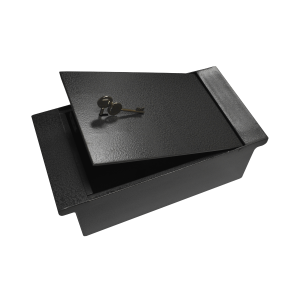Can I Bolt A Safe To The Floor Or Wall?
Choosing the right type of security safe is an important decision. While you don’t want to be paying over the odds for a large, expensive safe that you don’t necessarily need, it is also true that the bigger and heavier the safe is, the more security protection it gives you. That is because, however sophisticated the locking system is on a safe, if it can be picked up by an opportunist thief and taken away from the premises, then they have all the time in the world to try and pick the lock and bypass your security system to gain access to the safe and its contents. And even if they don’t, you are unlikely to get the safe back.
This is a common scenario where a business has a small cash box, for example. This might be used for petty cash and small valuables, and the locking system works perfectly well, but it is small and light and can easily be removed by a thief. This is where larger safes offer more security, and specifically because they can be bolted down to offer an added layer of security.
Why bolting a safe to the floor or wall is important
So yes, a safe can be bolted to the floor or wall, and it is important to understand how that is done and why it should be done. Returning to the above scenario, a home or business with a small portable safe would need to secure it by locking it away somewhere to add the required layers of protection. So a small cashbox could be locked in a set of drawers, while other safes can be concealed in cupboards, under the floor or behind wall art.
If you need a larger and more solid safe, for storing more bulky valuables, important documents or significant amounts of cash, then this is harder to hide and conceal because it is large and heavy, but it is also free-standing, so instead you need to bolt this to the floor or wall. This is a deterrent to a would-be thief, because if they can’t pick it up to take it away they will simply move on, they won’t have time to try and crack the lock, and this is where bolting your safe to the floor or wall adds an extra layer of security, as the safe cannot be removed from the premises.
A good security or fire safe should come with pre-drilled holes for securing it either to the floor, the wall or both. These holes are specifically for the installation process, and most safes will also come with the appropriate anchor bolts also.
Considerations when bolting your safe to the floor or wall
When installing a safe and securing it with bolts, there are a number of considerations you need to make:
- Insurance - In many cases securing the safe in this way will be a requirement of an insurance policy, in that, if the safe isn’t suitably secured then the contents won’t be insured. Equally, you shouldn’t drill holes in the safe yourself for securing with bolts, as this can compromise the safe’s structure and fire-retention properties, and hence your insurance policy.
- Solid surface - Whether you are securing the safe to a floor or a wall, you should ensure the surface it is being secured to is concrete or solid brick. This provides the best security, and you should also check the condition of the surface, if it is damp or crumbling it might not provide the required level of grip, and therefore security.
- Wooden floors – You shouldn’t bolt a safe to floorboards. These are not thick or strong enough and a thief could potentially rip a floorboard up along with the safe. If you are securing a safe to a wooden floor you should bolt it to a thick floor joist, and using proper wood screws.
- Tools – Make sure you use good quality tools, such as a strong masonry drill bit. You should also use a drill with a cord, rather than a cordless drill, because you need a lot of power to drill into a solid surface.
- Flush – When installing the safe you need to make sure it is flush to the surface it is being secured to, so that there is no opportunity for someone to achieve sufficient leverage to prize it away with a crowbar. So when securing the safe to a wall, remove any section of skirting board so that it can be bolted right up to the wall. And when securing to the floor, remove any section of carpet so the safe sits flush to the floor.
- Rental properties – If you are renting the property as a residential or commercial lease, you will need to ask permission from the landlord to bolt the safe in this way, as technically this is a structural change. You will also need to consider the fact that when you vacate the premises at the end of the lease, you will need to take the safe with you (unless the landlord agrees to keep it) so think about how you will un-secure the bolts to remove the safe in the future.
Contact MB Direct for advice on securing your safe
At MB Direct we can advise on the best security safes for the level of security you need, and we can also talk to you about installation and the process of bolting a safe to the floor or wall. This is an important element of properly protecting your valuables, belongings and documents and needs to be done correctly, so get in touch with our team today.